
WAIT! If you’re a subscriber reading this in email format, before reading any further, please click on the title of the post right above in order to view the blog in the glory it was meant to have on the actual blog website.
Happy New Year! I thought I’d send a little feathered beauty your way and some thought-provoking quotes to start off your 2015.
On why you should bird more in 2015:
“Looking at birds really takes away sadness in a lot of us,” said a woman featured in Jeffrey Kimball’s film (The Central Park Effect), a breast-cancer sufferer who ushers fellow birders on ambling tours of the park.
“It was one of the rare times in an adult’s life when the world suddenly seems more magical rather than less,” says writer Jonathan Franzen, a self-proclaimed “born-again bird watcher,” of the first time he went birding.
On why you should take a child outside often this year:
“If a child is to keep alive his inborn sense of wonder, he needs the companionship of at least one adult who can share it, rediscovering with him the joy, excitement, and mystery of the world we live in.”
― Rachel Carson
On why you should watch less TV this year:
“There are some who can live without wild things and some who cannot. For us in the minority the opportunity to see geese is more important than television” …Aldo Leopold (Sand County Almanac)

“Maybe it’s time we put down the remote control and go someplace remote where we aren’t in control.”
–Anonymous
On why you should strive to give back to nature this year:
“In every walk with nature, one receives far more than he seeks.” -John Muir
“In all of nature there is something of the marvelous.” -Aristotle
“I speak for the trees, for the trees have no tongues.” – The Lorax
“It is in the wild places, where the edge of the earth meets the corners of the sky, the human spirit is fed.” ~Art Wolfe
“If future generations are to remember us with gratitude rather than contempt, we must leave them a glimpse of the world as it was in the beginning, not just after we got through with it.” -President Lyndon B. Johnson
Tread lightly this year, get outside, go birding, learn all you can about nature and be a participant in conservation!
There’s a lot going on in the woods,
Blake

Spring Migration Banding Is Done, Summer MAPS has Begun!

NOTE to SUBSCRIBERS: For best viewing results of this blog, please click on the post title to view in your browser rather than email format. (There are many pictures to load).
We officially closed the spring migration banding station on May 24th, after the steady stream of migrants abruptly dried up. The total count for that day was a whopping 4 birds, including Gray Catbirds and one Indigo Bunting. The few days leading up to that final day were painfully slow as well, with our biggest day yielding just barely a baker’s dozen of birds. We knew it was time to pull the plug, though it’s always bittersweet to say goodbye to such a sensational season of over 300 winged wonders.


We noticed that we banded a few more species of migrant birds last spring than this spring; absentees from this year’s catch that were present last year include Worm-eating Warbler, Blue-winged Warbler, and Prairie Warbler. However, we did hear individuals of these species singing on occasion this spring, so it may have just been that we were lucky to get them in our nets last year (and unlucky this year). On the other hand, they may not have been as abundant at Rushton this spring as compared to last. We really can’t say much until we have long term banding records over many years. Of note, we did gain a species never before banded at Rushton, the Yellow Warbler!

A couple of days before close, we managed to scrounge up a nice assortment of birds for our last school group of the year, the Westtown first graders. The catch included a captivating Canada Warbler, several secretive Northern Waterthrush, a rambunctious Red bellied Woodpecker, a sweet Ovenbird, flamboyant Common Yellowthroats, and the first fledgling of the year, a Carolina Wren! With eyes as big as saucers, each child gazed in wordless awe upon the wild bird gently placed in their hands, as if seeing for the first time a woodland nymph they had only seen in fairytales! If each child walks away with that magical memory and the belief in the healing power and beauty of nature, then we consider it a success for the future of habitat conservation.


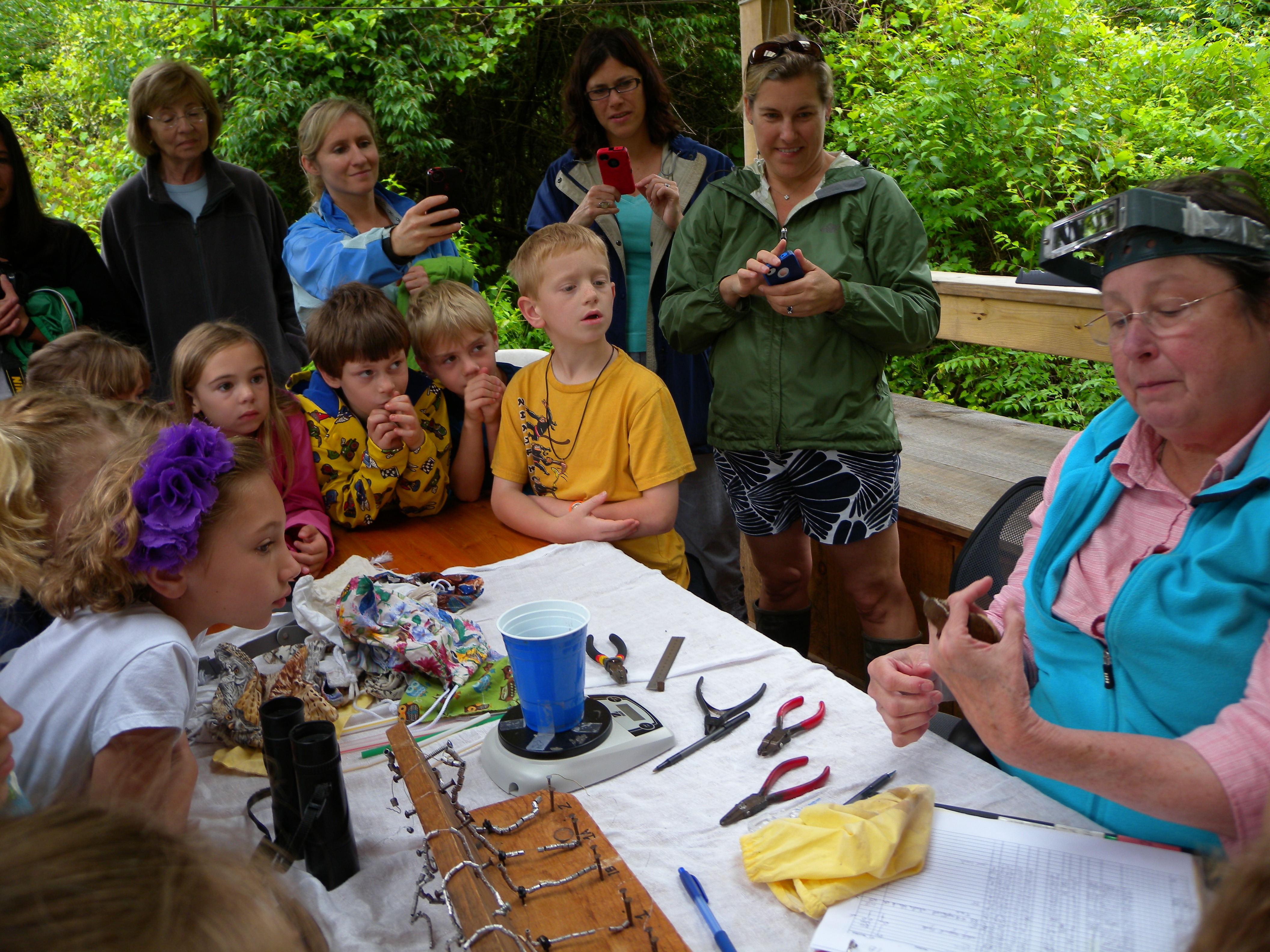

Our bird banding station not only contributes to global bird conservation (all of our data goes to the USGS where everyone else’s banding data is maintained) and helps us document Rushton’s bird populations, but it also serves as a means to connect people to nature through intimate experiences with birds. We strive to reach as many audiences as we can, young and old, black and white, urban and suburban, with this incredible experience and conservation message.

In my daily web wanderings, I came across this enlightening, entertaining, and wonderfully written article, “Black Birder in the Black Swamp”, by J. Drew Lanham. A birder of color himself, he writes about his birding (and people-ing) experience at Black Swamp Bird Observatory in Ohio for “The Biggest Week in American Birding”, an annual May event at one of the hottest birding meccas in the country where warblers are said to “drip from the trees” during migration. Lanham makes you feel like you’re right there alongside him with binoculars and makes a great case for the need to include a wider diversity of faces in the world of birding (and ultimately conservation). I strongly encourage you to check it out on his blog ” Wild and in Color”.

Also in that article is a reference to our “always affable Adrian Binns of Wildside Nature Tours“, who was also there for the “Biggest Day in American Birding” in Ohio. Back at Rushton Woods Preserve this past Saturday, June 9th, he charismatically lead the first annual PA Young Birders (PAYB) “Kids Get Out and Bird” program which was a huge success and a ton of fun. Twenty Young Birders, many of which were brand new faces to Rushton, excitedly trekked around the farm and woods searching for as many different types of bird nests as they could find. We investigated every nestbox and every nest for structural composition, eggs, nestlings, and species clues. They took turns recording the information, opening nestboxes (always thrilling!), and holding the baby birds (which is harmless by the way-the adults will NOT abandon their babies just because someone touched them). We found and identified over a dozen different nests of species including House Wren, Chickadee, Barn Swallow, Tree Swallow, Eastern Bluebird, Northern Mockingbird, Wood Thrush, and Downy Woodpecker. The children even got to participate in the banding of 4 of the farm’s bluebird babies! Check out Adrian’s summary and pictures on his blog, “Notes from the Wildside“.



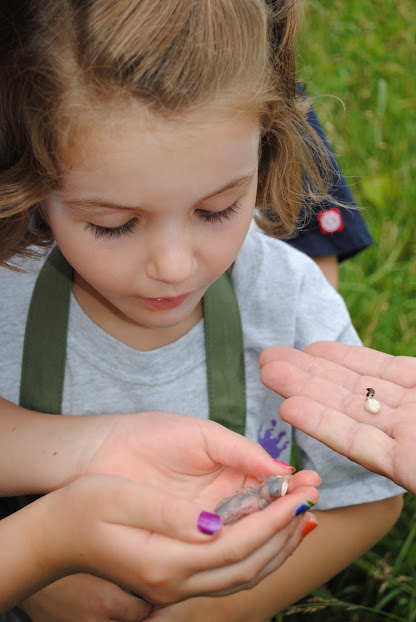


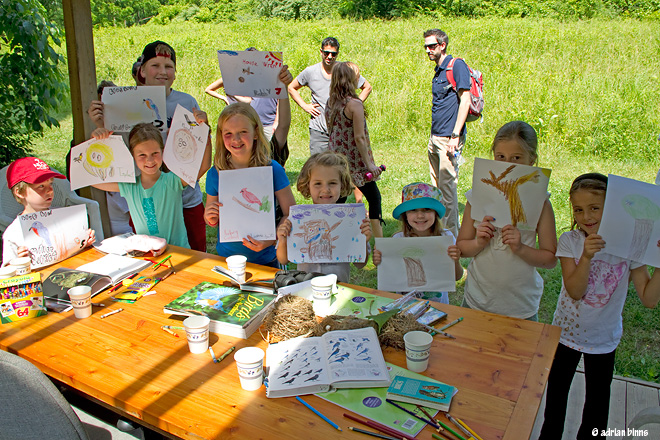
Now that migration is over until the fall, we are now banding breeding birds (and their young) in the woods of Rushton for MAPS, which stands for Monitoring Avian Productivity and Survivorship. This is the most important, data intensive project that a banding station can do. The program was started in 1989 by the Institute for Bird Populations (IBP) in Point Reyes, CA, and there are now just 500 certified, constant-effort MAPS stations in North America, including Rushton Woods Preserve and Farm (RUFA)! This will be our second summer of official MAPS station operation, and IBP requires a minimum 5 year commitment.

Unlike migration banding during which we try to get out as many days a week as we can, MAPS requires that we band for 6 hours once every 10 days during the breeding season, following strict IBP protocol that ensures that our data can be easily compared to continent-wide data. This involved clearing and setting up 10 new strategic net lanes throughout the preserve last summer, with each net a certain distance apart from the others within an 8 hectare total area. Then we completed a rigorous Habitat Survey Analysis of all the habitat types, plant species, and botanical structural composition of our study area.
Our resulting data will contribute to critical information on the ecology, conservation, and management of North American landbird populations, and the factors responsible for changes in their populations. Check out the IBP website to learn more about MAPS and the other important projects underway as well as their training programs. There, you will also find interesting bird banding resources and publications, including the MAPS annual report.

MAPS BANDING IS NOT OPEN TO THE PUBLIC. But don’t worry… I’ll keep you in the loop, and public fall banding will be here before you know it!
Unfortunately,we cannot accept visitors or any more volunteers (who do NOT have MAPS training) to our MAPS banding station at this time. Part of the reason why we only band once every 10 days during MAPS is to minimize disturbance to these breeding birds during an energetically expensive time in their lives. Many visitors and volunteers may cause too much disturbance to the birds and also to the banders who must focus their energy on rigorous data recording. If you are interested in getting involved with MAPS, I would encourage you to attend one of IBP’s training courses or complete a MAPS internship.

Our first MAPS session for this year was the first week of June. It was pretty slow with only 19 total birds banded (as compared to 32 in that period last year). The pace picked up this week with a total of 26 breeding birds banded including:
- Northern Cardinals
- Ovenbirds
- Red-bellied Woodpecker
- Common Yellowthroats
- Downy Woodpecker
- Veery
- Wood Thrushes
- Gray Catbirds
- Blue Jay
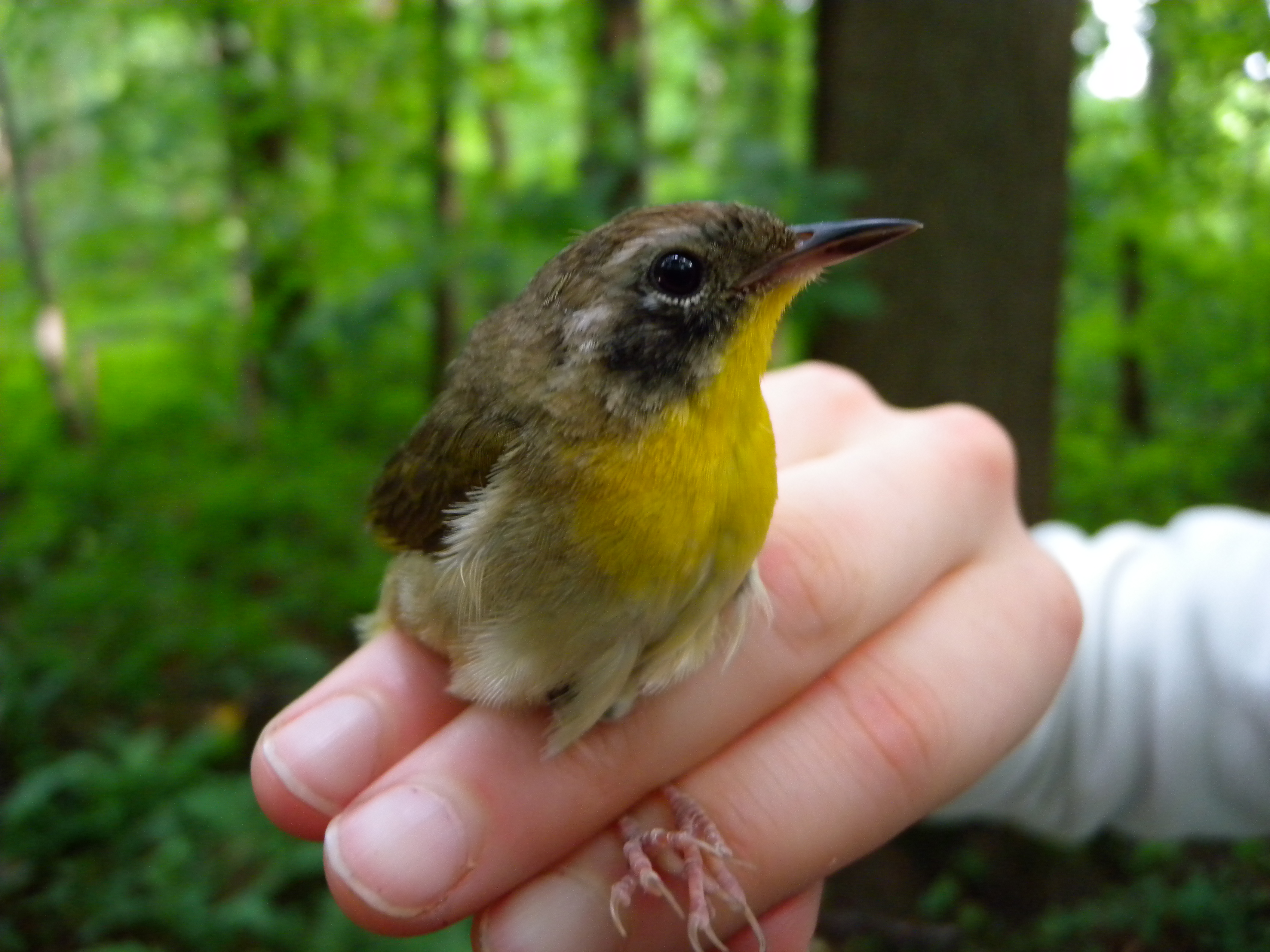


The Downy Woodpecker was our favorite. She just had so much character, and the endearing berry mustache around her beak told us she had just been dining in a delicious patch of wild raspberries. YUMMY.

Some birds breeding in the woods of Rushton are continually evading our nets, but we know they are present by their songs. The Scarlet Tanager is one such breeder, who spends most of his time high up in the canopy feeding on insects, spiders, buds and fruit. The Kentucky Warbler, whose cheery song was absent from Rushton last summer, is back this year! This handsome masked denizen of the dense, deciduous understory is bound to land in one of our nets at some point this summer…We hope. It would be a notable first for RUFA.

Well, I’m on vacation to Florida next week (I wonder what birds I’ll see there), but our long-time intern, Natalie Staples, will be guest blogging! She is the talented daughter of Cathy Staples, a Villanova poetry professor and published award-winning poet. Natalie is following in her mother’s footsteps and studying literature abroad in England next year! I know you’ll enjoy her blog presence.
In the mean time, I’ll leave you with;
A Couple of Books to Enjoy,
- Birding for Everyone: Encouraging People of Color to Become Birdwatchers by John C. Robinson
- The Bluebird Effect: Uncommon Bonds with Common Birds by Julie Zickefoose
A Couple of Bird ID Resources to Discover,
- NatureInstruct by USGS
- Inside Birding Series- You Tube by the Cornell Lab of Ornithology
And A Few Fun Things to Do!
- Join thousands of families for The Great American Backyard Campout on June 23rd for the National Wildlife Federation.
- Submit your photos, videos, stories or artwork of a “funky nest in a funky place” for the Cornell Lab of Ornithology’s Funky Nest 2012 competition.
- Participate in GO WILMA, a local outdoor adventure/summer reading program for K-5th graders and their families. Children receive Captain’s Logs from Malvern or Paoli libraries and then use the clues to search for stars hidden in special places this summer, including our own Rushton and Kirkwood Preserves. Go to willistownparks.org to find out more and get started!
May your summer be filled with new birds and new beginnings,
~Blake

Attracting Bluebirds to Your Backyard – Spots Left For Wednesday’s Program!
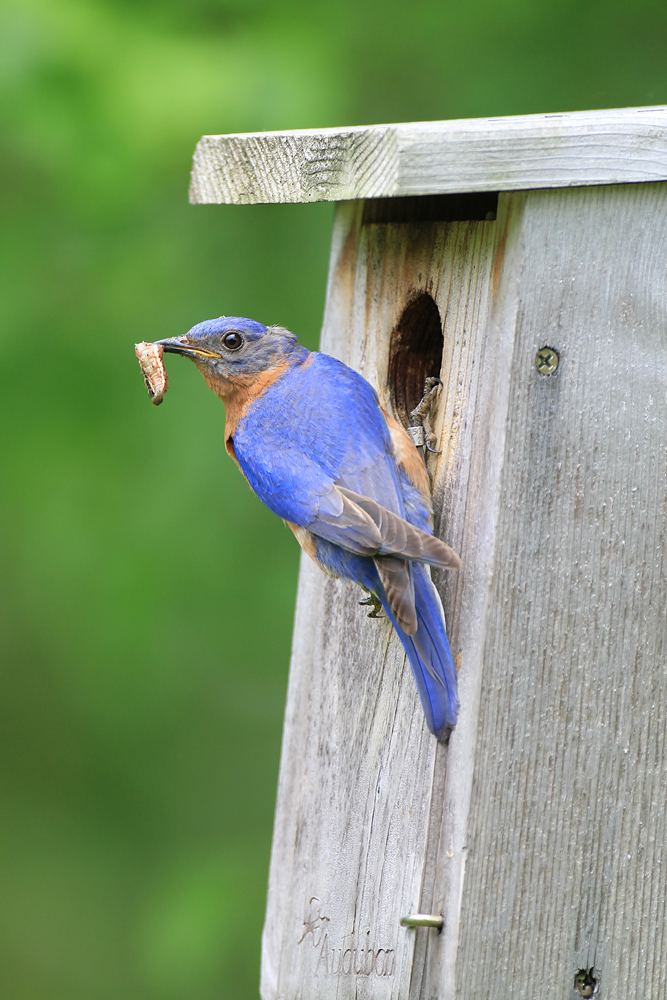
Spring is in the air and bluebirds are checking out the real estate!
Ken Leister, a State Coordinator for The Bluebird Society of Pennsylvania, will be speaking at the Trust’s office on Wednesday March 14th, at 6:30pm, to share his 12+ years of experience and expertise in attracting and monitoring bluebirds.
Attracting Bluebirds to Your Backyard – Spots Left For Wednesday's Program!

Spring is in the air and bluebirds are checking out the real estate!
Ken Leister, a State Coordinator for The Bluebird Society of Pennsylvania, will be speaking at the Trust’s office on Wednesday March 14th, at 6:30pm, to share his 12+ years of experience and expertise in attracting and monitoring bluebirds.





